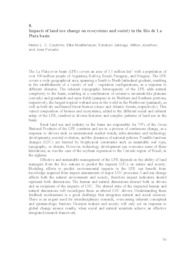Impacts of land use change on ecosystems and society in the Rio de La Plata basin.
Impacts of land use change on ecosystems and society in the Rio de La Plata basin.
Autoria: COUTINHO, H. L. da C.; NOELLEMEYER, E.; JOBBAGY, E.; JONATHAN, M.; PARUELO, J.
Resumo: The La Plata river basin (LPB) covers an area of 3.1 million km2 with a population of over 100 million people of Argentina, Bolivia, Brazil, Paraguay, and Uruguay. The LPB covers a wide geographical area, spanning a South to North latitudinal gradient, resulting in the establishment of a variety of soil - vegetation configurations, as a response to different climates. The inherent topographic heterogeneity of the LPB adds natural complexity to the basin, resulting in a combination of extensive savannah-like plateaus (cerrado) and grasslands and open fields (pampas) in its Northern and Southern portions, respectively, the largest tropical wetland area in the world in the Northwest (pantanal), as well as both dry and humid forest biomes (chaco and Atlantic forests, respectively). This varied composition of biomes and ecosystems, added to the different social and cultural setup of the LPB, resulted in diverse histories and complex patterns of land use in the basin. Rural land use and industry in the basin are responsible for 70% of the Gross National Products of the LPB countries and are in a process of continuous change, as a response to drivers such as international market trends, infra-structure and technology developments, societal evolution, and the dynamics of national policies. Possible land use changes (LUC) are limited by biophysical constraints such as unsuitable soil type, topography, or climate. However, technology development can overcome some of these limitations, as was the case of the soybean expansion to the Cerrado region of Brazil, in the eighties. Effective and sustainable management of the LPB depends on the ability of land managers from the five nations to predict the impacts LUCs on nature and society. Modeling efforts to predict environmental impacts in the LPB can benefit from knowledge acquired from impact assessments of major LUC processes. Land use change affects both the natural environment and society, therefore impact indicators should represent both dimensions. The human and natural dimensions interact both as drivers and as recipients of the impacts of LUC. The altered state of the impacted human and natural dimensions will reconfigure them as altered LUC drivers. Understanding these feedback mechanisms is a great challenge that integrates natural and social sciences. There is an urgent need for interdisciplinary research, overcoming inherent conceptual and epistemologic barriers. Decision makers and society will only act on response to global change science results, when social and natural scientists achieve an effective integrated research framework.
Ano de publicação: 2008
Tipo de publicação: Parte de livro (capítulos de livros, trabalhos e resumos publicados em anais ou em coletâneas)
Unidade: Embrapa Solos
Palavras-chave: Bacia do Rio Prata, Ecossistema, Uso da Terra, impacto
Observações
1 - Por padrão são exibidas publicações dos últimos 20 anos. Para encontrar publicações mais antigas, configure o filtro ano de publicação, colocando o ano a partir do qual você deseja encontrar publicações. O filtro está na coluna da esquerda na busca acima.
2 - Para ler algumas publicações da Embrapa (apenas as que estão em formato ePub), é necessário ter, no celular ou computador, um desses softwares gratuitos. Sistemas Android: Google Play Livros; IOS: iBooks; Windows e Linux: software Calibre.
Acesse outras publicações
Acesse a Base de Dados da Pesquisa Agropecuária (BDPA) para consultar o acervo completo das bibliotecas da Embrapa.

